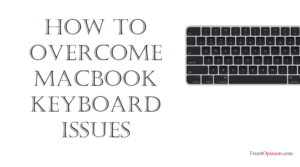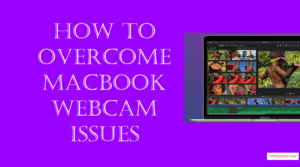In this comprehensive guide, we’ll delve into the significance of MacBook trackpads, explore common issues users may encounter, and provide practical solutions to overcome these challenges. Whether you’re a student, professional, or creative enthusiast, understanding and addressing trackpad-related issues is crucial for maximizing the usability and functionality of your MacBook.- MacBook Trackpad Issues

Table of Contents
- Introduction
- Understanding MacBook Trackpads
- What is a MacBook Trackpad?
- Role of the Trackpad
- Common MacBook Trackpad Issues and Solutions
- Unresponsive or Erratic Cursor Movement
- Causes
- Solutions
- Inconsistent Gesture Recognition
- Causes
- Solutions
- Physical Damage or Wear
- Causes
- Solutions
- Trackpad Not Clicking or Stuck
- Causes
- Solutions
- Unresponsive or Erratic Cursor Movement
- Conclusion
Introduction
The trackpad is a fundamental input device on your MacBook, providing precise cursor control, intuitive gesture support, and seamless navigation across applications and interfaces. Whether you’re scrolling through documents, multi-tasking with Mission Control, or executing multi-finger gestures for productivity, the trackpad plays a pivotal role in enhancing user experience and productivity. However, MacBook trackpads can encounter issues that hinder performance, responsiveness, and overall usability.
Understanding MacBook Trackpad Issues
Before delving into specific issues and solutions, it’s essential to understand the role of the trackpad in MacBook devices and its significance in facilitating navigation, input, and interaction.
- What is a MacBook Trackpad?
- The trackpad, also known as the touchpad or glide pad, is a built-in pointing device on a MacBook that allows users to control the cursor, perform gestures, and interact with on-screen elements using touch input.
- MacBook trackpads feature multi-touch support, allowing users to perform a variety of gestures such as scrolling, zooming, rotating, and swiping with multiple fingers.
- Role of the Trackpad:
- Cursor Control: The trackpad enables users to move the cursor, click, and interact with on-screen elements using precise touch input, eliminating the need for an external mouse.
- Gesture Support: Multi-touch gestures such as two-finger scrolling, pinch-to-zoom, and three-finger swiping provide intuitive navigation and efficient multitasking capabilities.
- Accessibility Features: Built-in accessibility features such as Tap to Click, Three-Finger Drag, and Trackpad Zoom enhance usability and accommodate users with different preferences and needs.

Now that we’ve established the significance of MacBook trackpads, let’s explore common trackpad issues and strategies to address them effectively: MacBook Trackpad Issues
Common MacBook Trackpad Issues and Solutions:
- Unresponsive or Erratic Cursor Movement:
- Symptoms: The cursor on the screen moves erratically, jumps randomly, or fails to respond to trackpad input consistently.
- Causes:
- Software Glitches: macOS bugs, driver conflicts, or incompatible software installations can cause trackpad-related issues and erratic cursor behavior.
- Hardware Malfunctions: Wear and tear on the trackpad mechanism, damaged sensors, or loose connections can lead to trackpad unresponsiveness or erratic movement.
- Moisture or Contaminants: Spills, moisture, or debris on the trackpad surface or underneath the trackpad button can interfere with sensor readings and disrupt cursor movement.
- Solutions:
- Clean the Trackpad: Use a soft, lint-free cloth dampened with water or isopropyl alcohol to clean the trackpad surface and remove any residue, fingerprints, or debris. Gently wipe the trackpad in circular motions to ensure thorough cleaning.
- Reset SMC and NVRAM/PRAM: Reset the System Management Controller (SMC) and Non-Volatile Random Access Memory (NVRAM) or Parameter RAM (PRAM) to recalibrate hardware settings and resolve trackpad-related issues. Instructions for resetting the SMC and NVRAM/PRAM vary depending on the MacBook model.
- Test in Safe Mode: Boot the MacBook in Safe Mode (hold Shift during startup) to diagnose and troubleshoot software-related issues that may be affecting trackpad responsiveness. If the trackpad functions correctly in Safe Mode, it indicates that third-party software or drivers may be causing the problem.

2. Inconsistent Gesture Recognition:
- Symptoms: Multi-touch gestures such as scrolling, zooming, or swiping fail to register consistently or perform erratically on the trackpad.
- Causes:
- Software Conflicts: Incompatible or outdated trackpad drivers, macOS updates, or third-party software installations can interfere with gesture recognition and functionality.
- User Preferences: Incorrect trackpad settings or preferences related to gesture sensitivity, speed, or behavior can affect gesture recognition and responsiveness.
- Physical Obstructions: Obstacles such as dirt, moisture, or debris on the trackpad surface can disrupt touch input and hinder gesture recognition.
- Solutions:
- Update macOS and Drivers: Ensure that macOS and trackpad drivers are up to date with the latest updates and patches. Visit the Mac App Store or the manufacturer’s website to download and install updates for macOS and trackpad drivers.
- Adjust Trackpad Settings: Navigate to the Trackpad preferences in System Preferences and adjust the trackpad settings to your preference. Experiment with gesture sensitivity, scrolling speed, and gesture assignments to optimize gesture recognition and responsiveness.
- Perform Trackpad Calibration: Use built-in macOS utilities or third-party calibration tools to calibrate the trackpad and adjust touch sensitivity, pressure detection, and gesture recognition. Follow on-screen instructions to complete the calibration process and improve trackpad performance.
3. Physical Damage or Wear:
- Symptoms: Visible damage, scratches, or wear on the trackpad surface, worn-out trackpad buttons, or loose trackpad assembly.
- Causes:
- Accidental Damage: Drops, impacts, or mishandling of the MacBook can cause physical damage to the trackpad, buttons, or surrounding enclosure.
- Mechanical Wear: Continuous usage over time can lead to mechanical wear and tear on the trackpad mechanism, resulting in reduced responsiveness or button failure.
- Manufacturing Defects: Quality control issues or manufacturing defects in the trackpad assembly can manifest as physical damage or premature wear.
- Solutions:
- Inspect for Damage: Carefully inspect the trackpad surface, buttons, and surrounding enclosure for signs of damage, scratches, or wear. Pay close attention to areas where debris or contaminants may accumulate, such as the edges of the trackpad.
- Replace Trackpad Components: If the trackpad buttons are worn out or damaged, consider replacing the trackpad assembly or individual components such as the trackpad button mechanism. Replacement parts and trackpad assemblies are available from authorized service providers.
- Seek Professional Repair: If physical damage is severe or beyond your ability to repair, seek professional repair services from Apple Support or authorized service providers. Certified technicians can assess the extent of the damage and recommend appropriate repair or replacement options.

4. Trackpad Not Clicking or Stuck:
- Symptoms: The trackpad fails to click or register button presses, feels stiff or sticky when pressed, or gets stuck in the depressed position.
- Causes:
- Debris Accumulation: Dust, crumbs, or debris trapped underneath the trackpad button mechanism can prevent the button from clicking or cause it to stick.
- Mechanical Wear: Wear and tear on the trackpad button mechanism, including worn-out springs or hinges, can result in reduced click responsiveness or button failure.
- Liquid Spills: Accidental spills of liquids such as water, coffee, or soda can seep into the trackpad mechanism, causing buttons to stick or malfunction.
- Solutions:
- Clean the Trackpad Button: Use compressed air or a soft brush to gently clean the trackpad button mechanism and remove any dust, debris, or particles. Alternatively, use a cotton swab moistened with isopropyl alcohol to clean the button mechanism.
- Lubricate the Trackpad Button: Apply a small amount of silicone lubricant or dry graphite lubricant to the trackpad button mechanism to reduce friction and improve click responsiveness. Exercise caution to avoid over-lubrication, which can attract dust and debris.
- Replace Trackpad Button: If cleaning and lubrication fail to resolve button issues, consider replacing the trackpad button mechanism or the entire trackpad assembly. Replacement parts and trackpad assemblies are available from authorized service providers.
Conclusion:
Mastering MacBook trackpad issues is essential for maintaining productivity, efficiency, and user satisfaction. By understanding the significance of the trackpad, identifying common issues, and implementing targeted solutions, users can optimize trackpad performance, mitigate input-related challenges, and maximize the usability of their MacBook. – MacBook Trackpad Issues
Whether troubleshooting unresponsive cursor movement, addressing gesture recognition issues, diagnosing physical damage, or resolving trackpad button problems, proactive maintenance and informed decision-making are key to ensuring a seamless navigation experience on your MacBook. Remember to follow best practices, consult official documentation, and seek assistance from Apple Support or authorized service providers when addressing complex trackpad issues.
With the knowledge and strategies outlined in this guide, you can confidently navigate MacBook trackpad tribulations, unlock the full potential of your device, and enjoy smooth and intuitive navigation for years to come.




